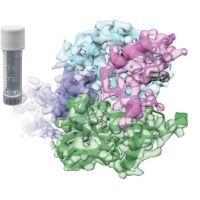Specification
| Description | Recombinant protein from the full-length sequence of Homo sapiens pleckstrin homology and FYVE domain containing 1 (PLEKHF1) (NM_024310). |
| Organism | Homo sapiens (Human) |
| Expression Host | Human Cells |
| Tag Info | His or DYKDDDDK. Please contact us if you need further information or require specific designed tag. |
| Purity | Greater than 90% by SDS-PAGE gel |
| Uniprot ID | Q96S99 |
| Entry Name | PKHF1_HUMAN |
| Gene Names | PLEKHF1 APPD LAPF ZFYVE15 |
| Alternative Gene Names | APPD LAPF ZFYVE15 |
| Alternative Protein Names | Pleckstrin homology domain-containing family F member 1 (PH domain-containing family F member 1) (Lysosome-associated apoptosis-inducing protein containing PH and FYVE domains) (Apoptosis-inducing protein) (PH and FYVE domain-containing protein 1) (Phafin-1) (Zinc finger FYVE domain-containing protein 15) |
| Application | Antigens, Western, ELISA and other in vitro binding or in vivo functional assays, and protein-protein interaction studies; For research & development use only! |
| Buffer | Purified protein formulated in a sterile solution of PBS buffer, pH7.2, without any preservatives |
| Endotoxin | Endotoxin level is < 0.1 ng/µg of protein (<1EU /µg) |
| Length | 279 |
| Molecular Weight(Da) | 31195 |
| Protein Sequence | (The sequence of expressed protein may have some variation from the sequence shown below. Please contact us for the exact sequence.) MVDHLANTEINSQRIAAVESCFGASGQPLALPGRVLLGEGVLTKECRKKAKPRIFFLFNDILVYGSIVLNKRKYRSQHIIPLEEVTLELLPETLQAKNRWMIKTAKKSFVVSAASATERQEWISHIEECVRRQLRATGRPPSTEHAAPWIPDKATDICMRCTQTRFSALTRRHHCRKCGFVVCAECSRQRFLLPRLSPKPVRVCSLCYRELAAQQRQEEAEEQGAGSPGQPAHLARPICGASSGDDDDSDEDKEGSRDGDWPSSVEFYASGVAWSAFHS |
Background
| Function | FUNCTION: May induce apoptosis through the lysosomal-mitochondrial pathway. Translocates to the lysosome initiating the permeabilization of lysosomal membrane (LMP) and resulting in the release of CTSD and CTSL to the cytoplasm. Triggers the caspase-independent apoptosis by altering mitochondrial membrane permeabilization (MMP) resulting in the release of PDCD8. {ECO:0000269|PubMed:16188880}. |
| Pathway | |
| Protein Families | |
| Tissue Specificity | Highly expressed in heart and skeletal muscle. Weakly expressed in brain, thymus, spleen, kidney, liver, small intestine, placenta and lung. {ECO:0000269|PubMed:16188880}. |
QC Data
| Note | Please contact us for QC Data |
| Product Image (Reference Only) |  |

